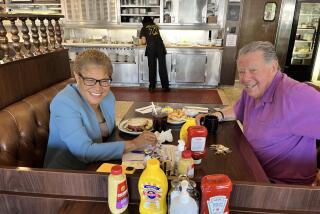Beset by Problems, Banning Residents Organize So They Won’t Have to Say . . . : THERE GOES THE NEIGHBORHOOD
In a part of Los Angeles best known for smokestacks, oil wells, shipping containers and junkyards, the neighborhood near the Phineas Banning mansion in Wilmington is an oasis.
Large, distinctive homes with thick green lawns line wide avenues leading to the 123-year-old mansion, now a city-run museum. Many of the homes are said to have been built in the 1920s by executives of the Wilmington Transportation Co., a tugboat business once owned by Banning, the founder of what is now the Port of Los Angeles.
Today, longtime Wilmington residents, who as children dreamed of moving to the historic neighborhood, live beside newcomers who were attracted by the area’s affordable elegance.
“We got a house that was twice as big as the one we had before, with plenty of yard space. Similar houses in Torrance cost twice as much,” said Theresa Hollis, who moved to the neighborhood from Gardena with her husband and two children last spring. But “when you tell someone that you live in Wilmington, you immediately have to explain.”
Many Wilmington residents have long praised the predominantly Latino community as a proud, neighborly and hard-working corner of Los Angeles. But Wilmington, they acknowledge, is also an industrial port community with a gamut of urban problems: gang shootings, drug trafficking, illegal dumping, industrial pollution and homelessness.
The Banning neighborhood, where most homes sell for between $150,000 and $200,000, had been spared many of those problems--until now, residents say. Somewhat ironically, residents point to a city-sponsored cleanup in other parts of Wilmington as the source of some of their new problems, and have turned for help to a city government 30 miles away in downtown Los Angeles.
“This is the best neighborhood in Wilmington, and we want to keep it that way,” said Thomas Ponce, a retired construction worker who moved to the 1200 block of Banning Boulevard nine years ago. “We are trying to get the city to do its job. They have been neglecting the neighborhood.”
Los Angeles Councilwoman Joan Milke Flores, who represents Wilmington, rejects claims that the city has neglected the neighborhood, but she acknowledged in an interview that the area has come upon hard times. Flores, who took a tour of the area recently with some residents, said it has the same problems as any neighborhood surrounded by industry.
“This is a very nice neighborhood. I’ve always felt it is one of the nicest neighborhoods in the harbor area,” Flores said. “I feel their frustration in needing some help.”
Last month, residents formed the Banning Park Neighborhood Assn., an organization dedicated “to preserving our beautiful and historic neighborhood”--roughly 100 homes in the 1200 blocks of Banning Boulevard and Broad, Lakme and Cary avenues. In practical terms, the neighborhood’s coming together has meant outings to clean up alleys, paint over graffiti and lobby city officials to remove abandoned vehicles and other garbage in the neighborhood and adjacent areas.
“We are afraid that if some of these situations are not cleaned up, they will attract other things,” said Evelyn Romberg, a native of Wilmington who has lived on the 1200 block of Lakme Avenue since 1950. “Harbors are never the most beautiful places in the world, and I think people instinctively know that, so they head south to the water to unload their problems.”
City officials and Banning residents point to recent city-supported efforts to attract more business to blighted industrial areas of Wilmington as the source of some of the neighborhood’s problems.
Transients Nearby
Transients uprooted by an ongoing, city-mandated cleanup of the Wilmington Industrial Park in south Wilmington have migrated to other parts of the community, some setting up makeshift shelters near the Banning neighborhood in abandoned cars, beneath oil derricks and in alleys. Illegal dumpers from throughout the Los Angeles area, who for years have left refuse in the industrial park, have also turned to other vacant lots, some of them not far from the Banning neighborhood.
Residents complain of an increase in panhandlers passing through the neighborhood, stopping residents on the streets and sleeping at nearby Banning Park. Some say they are afraid to use the alleys behind their homes because of strangers passing through, and very few parents allow their children to play at the park by themselves.
Others complain about garbage and junk dumped in nearby vacant lots, and about alleys cluttered with abandoned vehicles, furniture and appliances.
City officials and police say that although the neighborhood has some legitimate concerns, its problems pale in comparison to other parts of Los Angeles, including other neighborhoods in Wilmington.
“If you look citywide, their situation is minor compared to other areas,” said Robert Steinbach, chief inspector for the conservation bureau of the city’s Department of Building and Safety and a former Wilmington resident. “But to them, it is not minor. It is serious. . . . And I can understand that.”
In an incident that some say illustrates the neighborhood’s changing character, Fred Torres, who owns a tool business in Artesia, was robbed at gunpoint outside his Lakme Avenue home as he left for work one morning several months ago.
Torres’ wife, Becky, scared the gunman away when she tried to run over him with her car. Torres, who now carries a baseball bat when he goes outside, said the disheveled gunman was one of many new faces that neighbors report roaming the streets.
“They are bringing their low quality of life into our neighborhood, and they are bringing us down with them,” said Simie Seaman, a neighbor of Torres who moved to the neighborhood from Torrance because of its “gorgeous homes and sense of history.” Seaman, who owns a cleaning business with her sister, is president of the Banning Park Neighborhood Assn.
‘Gone Downhill’
“When you are in your homes, it is like being in heaven,” said Seaman, who shares a 2,700-square-foot house with her husband and sister. “But the surroundings are disgusting. This little area has gone straight downhill.”
City inspectors cited 14 abandoned vehicles in a square-mile area south of the Banning mansion early this summer during a sweep prompted by residents’ complaints. They also issued 25 citations to property owners for such things as abandoned refrigerators, excessive vegetation and storage of inoperable vehicles.
John Hasselbrink, senior inspector for the Department of Building and Safety, said the department does not have enough inspectors to keep a regular watch on negligent property owners such as those cited during the sweep. The department responds only to specific complaints, he said.
“Years ago, we used to go block by block and evaluate properties, and that eliminated a lot of these problems,” Hasselbrink said. “But we just don’t have the manpower anymore.”
Flores said her office pushed for the sweep by the Building and Safety inspectors, and also prompted a program by Exxon and other oil companies to clean up properties throughout Wilmington where they operate wells. The oil companies are landscaping and fencing the properties, which for years have been favorite dumping sites and hangouts for transients.
“The key is to deal with the problem as soon as you see it, and that is what we are doing,” said Flores, who has been a favorite target of residents disgruntled about the amount of attention their problems receive from the city.
The Los Angeles Police Department’s Harbor Division does not keep separate crime statistics for the neighborhood, but aside from arrests for lewd activity at Banning Park, police said they have not noticed a dramatic increase in crime in the area.
Police arrested 62 men at the park during the first six months of this year for lewd conduct, the most at any park in the harbor area. Police attribute the arrests to a vice-squad crackdown rather than a sudden increase in lewd activity.
Problems Relatively Small
Capt. David Gascon told a group of homeowners several months ago that the department can do little about transients begging for money or passing through the neighborhood. He said crime problems in the Banning area, while distressing to residents, are relatively small compared to other areas of the community.
“I think this is a very decent neighborhood,” Gascon told the group. “I don’t think that anybody should be packing their bags and moving.”
Capt. Robert A. McVey, who heads the Harbor Division, attributed fears in the neighborhood more to a new awareness among homeowners of crime and other problems in Wilmington than to a sudden increase in crime.
“There are a lot of areas that are worse than Banning,” McVey said. “They are not as bad off as they would like to say.”
But residents point to several incidents this summer as evidence that the neighborhood’s problems are real. A 17-year-old resident of the 1200 block of Banning Boulevard opened his front door one day to find another youth pointing a gun at him. The gunman fled when the resident attempted to knock the gun away, police said.
Several weeks earlier, a 41-year-old woman was held up by two men with knives in the parking lot of a supermarket on Avalon Boulevard, several blocks from the Banning neighborhood. Neighborhood leaders have asked the store to increase lighting in the parking lot and better patrol the store.
“A lot of people now go to Carson to do their shopping,” said Joe Vargas, an oil-tank farm operator who moved to Lakme Avenue in 1975. “We want to shop in Wilmington, but not at the risk of our lives.”
And late last month, garage fires were reported at two homes about a block from the Banning neighborhood. Residents said that as many as 30 people, some with suitcases, had been seen at one of the garages and that human feces had been dumped into the alley behind the same garage.
“The police say things aren’t that bad here,” said Romberg. “Well, maybe in comparison to shootings on the freeways it isn’t so bad, but then where do (the police) live? Not here. They are not faced with the things that we have going on here.”
While neighborhood residents point with pride to the response they have been able to muster from city officials (the Banning Park Neighborhood Assn.’s most recent newsletter boasts that more than 200 abandoned vehicles have been hauled out of Wilmington since Banning residents began complaining in April), they place most of their hope for the future not in the city, but in themselves.
“People said we were crazy when we told them we were moving to Wilmington,” said Hollis, the newcomer on Banning Boulevard who is secretary of the neighborhood association. “But we decided that we could have a nice life in this house. We decided that we could face the problems by becoming active in the neighborhood.”
Seaman, the association’s president, agreed:
“People realize what they have here, and they know that if we aren’t careful, this place will look like the rest of Wilmington. It is like a cancer. And we are determined to stop it.”
More to Read
Sign up for Essential California
The most important California stories and recommendations in your inbox every morning.
You may occasionally receive promotional content from the Los Angeles Times.










